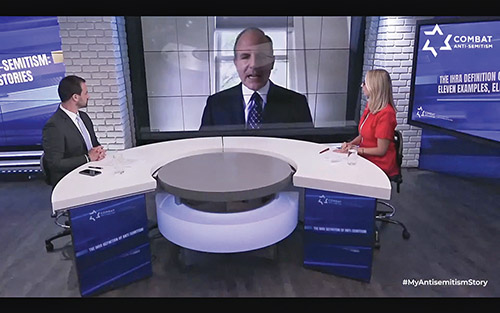

On Wednesday, September 16, the Combat Anti-Semitism Movement (CAM) organized a live event to demonstrate the urgent threat of anti-Semitism in all its forms. The 90-minute online program showcased the International Holocaust Remembance Alliance’s (IHRA) working definition of anti-Semitism, encompassing the full range of hate Jews around the world have been facing. Distinguished diplomats, Zionists, journalists and victims of anti-Semitism all spoke to assess the hatred harbored against Jews. Specifically, the program identified 11 types of anti-Semitism, and victims exemplified these definitions and shared heart-wrenching stories.
CAM director Sacha Roytman-Dratwa opened the event. “In order to defeat the scourge of anti-Semitism,” he explained, “we must first define it.” He contended that every facet of anti-Semitism must be recognized and its definition must be amended in real time.
The first definition identified the anti-Semitic tendency to call for, aid or justify the killing of Jews. The conversation focused on the shooting at the Chabad of Poway, where Jonathan Morales, a synagogue member and border patrol agent, helped take down the attacker. He remembered vividly that he heard shooting at the end of the fifth aliyah. The shooter, who had posted a hate-filled manifesto online, exemplified the senseless, murderous hatred contained in the overarching definition of anti-Semitism.
Another definition described how Jews are often the victims of mendacious, dehumanizing and stereotypical allegations. Professor Hannah Newman, a Holocaust survivor and teacher at Point Park University in Pittsburgh, led the accompanying discussion. In 2018, she was told that a complaint had been received about her, from a student, and she was immediately removed from the school without explanation. “This was part of a campaign to get me silenced, to vilify me,” she said, claiming that this was the work of trained BDS advocates. Newman was a renowned professor whose affiliation with Zionist groups like the ADL was the subject of frustration for other, anti-Zionist professors who sought to maintain a one-sided narrative against Israel.
Michaela Küchler, ambassador and chair of the IHRA, weighed in: “[The IHRA definition] mainly contributed to broaden the discussion about all the various forms of anti-Semitism. At the same time it led to vital debates around how we can identify and, most importantly, combat anti-Semitism.”
The issue is that anti-Semitism comes in many shapes and sizes, and the definition provides a framework within which all of these dimensions can be uniquely defined. By educating people about these distinctions, one can get a glimpse at the true nature of this hatred in all its forms, so that leaders and educators can set a precedent for how to combat hate. Küchler explained that anti-Semitism is in the mainstream. Thirty-four IHRA countries have already made unequivocal and powerful statements by adopting the definition at national, local and regional levels.
In 2018 Rafal Pankowski, a Polish sociologist and political scientist, was accosted by Holocaust deniers in Poland. He believes that since 2018 there has been a revival of anti-Semitic discourse due to online spread of extremist ideologies. This has led to another facet of the definition: accusing Jews of being responsible for real or imagined wrongdoings. Pankowski claimed that Holocaust denial is part and parcel of this definition, as the ideology accuses Jews of creating the myth of the Holocaust.
Elan S. Carr, the U.S. special envoy for monitoring and combating anti-Semitism, described, “This isn’t an American phenomenon. America still remains the most philo-Semitic country in history, but even in America anti-Semitism is rising. It is rather a global problem which requires a coordinated global solution.”
Leaders across the globe cannot be galvanized into a campaign against anti-Semitism without a cogent case for its urgency. Carr emphasized that hate against Jews often completely lacks rationality and therefore people debate whether this hate exists. As illustrated in horrific shootings like those in Pittsburgh and Poway, Jews are the victims of hateful forces beyond rational motives.
Dr. Felix Klein, the federal commissioner for Jewish life in Germany, developed a system where anti-Semitic incidents can be more easily recorded, enabling victims to receive support, counseling and legal help. He said, “The working definition of the IHRA is an essential tool in that fight because anti-Semitism is an international phenomenon and when you want to fight a disease…you have to define it and get the diagnosis before the therapy.”
Ahmed Shaheed, UN rapporteur on freedom of religion or belief, acknowledged that parts of the UN—such as the human rights council—judge Israel by an unfair standard. He said that anti-Semitic conspiracies and hate-filled views in general have been amplified because of the internet.
“If we really want to address this growing tsunami of xenophobia and hatred,” Shaheed asserted, “we have to begin by attacking the oldest form of hatred that underlies all of these, and that is tackling anti-Semitism.”
In the face of this ideological disease, UNESCO has worked tirelessly to promote Holocaust education and Shaheed is personally invested in fighting the link between anti-Semitic discourse and violence.
You can join the Combat Anti-Semitism Movement pledge at www.combatantisemitism.org/thepledge.
The entirety of IHRA’s working definition can be found on www.holocaustremembrance.com.
By Josh Gindi











